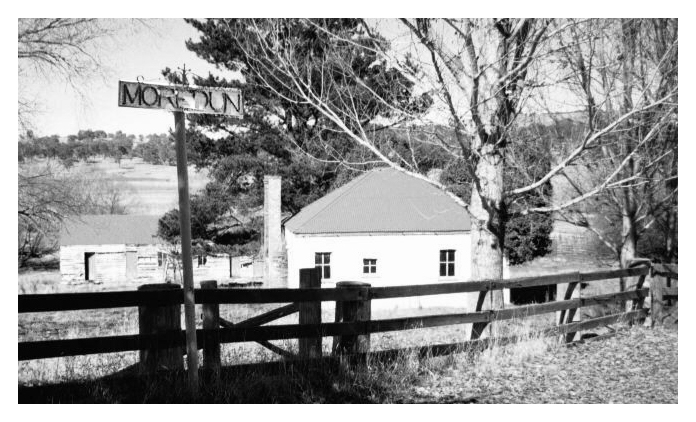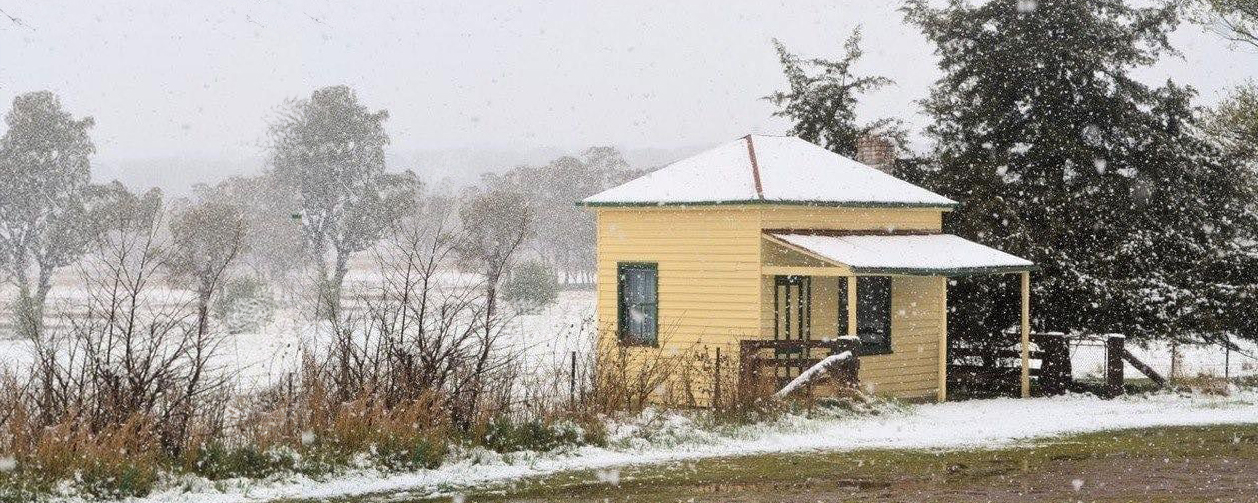Jane was just 10
years old early in 1845 when she and her siblings were brought by their
parents half way around the world, from the green fields of northern
Ireland to the dry paddocks of the New England area of New South
Wales. In Ireland, her father John was a farm labourer, and so the
day-to-day life on a station property may not have been all that
different for the young Jane.

The
first station the family worked on was
Moredun
(left), owned by Andrew Wauchope, a squatter who had
sponsored the family's immigration to Australia. Although the stations
in the New England, like elsewhere in Australia, were, by the standards
of the British Isles, huge in area, the workers on the properties
obviously had chances to intermingle and socialise. As a result, a
teenage Jane met up with another Irish emigrant, the considerably older
Garrett Farrell, who had arrived in the colony five years before the
Clark family.
One of Jane's sons said later his mother had married in 1850 while
at
Moredun, although the church
records, which pre-dated civil registration in NSW, say the property for
the ceremony was the nearby
Newstead.
Wherever the wedding took place, Jane, along with her parents and
siblings, was very soon living and working with Garrett on
Ollera
station, a pioneering property set up by the Everett brothers in 1838.
At
Ollera, workers were encouraged to grow their
own crops and tend their own livestock, using station facilities as
needed. This led to many families remaining on the land there for
decades and generations, including that of Garrett and Jane, and the
Clarks.
While Garrett worked in whatever capacity the Everetts needed, he was
primarily a bullock-driver, often away for days and weeks at a time,
taking sheep, wool and cattle to Grafton or Morpeth, the nearest ports
both some hundreds of kilometres away. Jane soon adapted to her
new life, filling many roles at
Ollera, including
the community's mid-wife. In one year of the property's records, 1857,
she was paid 'wages" of
£11
for unspecified work. According to one university researcher who
studied the
records of Ollera
station;
....the
wives and children of Ollera's shepherds and labourers supplemented
their families income by keeping a milking cow, raising a few pigs,
and tending poultry of several kinds....horses, which were an
expensive necessity, were often paid-off or taken in lieu of wages,
and there are several cases of their purchase by women. Mrs
Jane Farrell, whose husband was frequently away with the bullock
team, paid £25
for a horse in 1859.
One
item in the 1862 records written by the station manager David
Mackenzie, amusing to later readers, relates to the birth of his
daughter Charlotte Ethel, whose arrival may have been
attended only by the midwife Jane Farrell:
The entry for that busy day mentions "only the baby's
birth in mid morning and her black hair, and [then] records,
with unintentional irony, the unsatisfactory lambing rates
produced by one of the shepherds".
By the 1880s, Jane's husband Garrett by then nearing 70, had
stepped back from driving cattle herds to somewhat easier work as
a shepherd - but Jane continued to be active in looking after the
family's livestock ventures which the Ollera management
encouraged for its workers. When practical, this
encouragement extended to use of the property's facilities, as
seen in this letter from Jane to the owners (note - Jane was
illiterate when she arrived in Australia according to the
immigration records, so either this letter was written for her, or
she had somehow acquired schooling along the way):
Jane had a formidable reputation. In the obituaries which
followed her death in 1916, it was said that
Mrs
Farrell at all times led a most useful and active life, and in
her younger days was the first to be called on in case of
sickness, and her services were not sought in vain, even though
it meant a long ride in the middle of the cold at winter's
night.

Jane and Garrett had eight children (four each of boys and
girls). Not all the children reached adulthood, and of those
that did, only three lived to what could be called 'old
age'. Their youngest daughter, Sarah, who married David
Johnstone Davidson and who went off with him to the Western
Australian goldfields at the turn of the 20th century, died at
Kalgoorlie in 1901, her death at age 34 caused by a form of food
poisoning.
Sometime after his mother's death, one of Sarah's sons,
James, known as Harry, came back to Ollera and its nearby
village of Wandsworth, to live with Jane, his
grandmother. Harry went to school at Wandsworth and left
from the village to join the AIF in World War 1.
While Harry was in training in England in 1916, Jane died, without
seeing the last postcard her grandson had sent.
left: Jane's grave at the Ollera homestead
cemetery


 The
first station the family worked on was Moredun
(left), owned by Andrew Wauchope, a squatter who had
sponsored the family's immigration to Australia. Although the stations
in the New England, like elsewhere in Australia, were, by the standards
of the British Isles, huge in area, the workers on the properties
obviously had chances to intermingle and socialise. As a result, a
teenage Jane met up with another Irish emigrant, the considerably older
Garrett Farrell, who had arrived in the colony five years before the
Clark family.
The
first station the family worked on was Moredun
(left), owned by Andrew Wauchope, a squatter who had
sponsored the family's immigration to Australia. Although the stations
in the New England, like elsewhere in Australia, were, by the standards
of the British Isles, huge in area, the workers on the properties
obviously had chances to intermingle and socialise. As a result, a
teenage Jane met up with another Irish emigrant, the considerably older
Garrett Farrell, who had arrived in the colony five years before the
Clark family.

